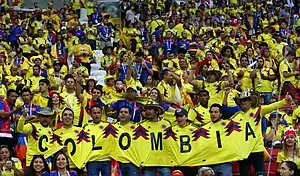Colombianos Mestizos | |
|---|---|
 Colombian Soccer fans in Russia, showing the diversity of Colombians. | |
| Total population | |
| 47%,[1] 49%,[2] 53.2%,[3] or 58%[4] of Colombians | |
| Regions with significant populations | |
| Throughout the nation, primarily in the Andean, Orinoco and Caribbean regions | |
| Languages | |
| Predominantly Colombian Spanish, minority usage of English, Italian, German and Indigenous languages of the Americas | |
| Religion | |
| Christianity (Catholic) | |
| Related ethnic groups | |
| White Colombians, Andalusians, Basques, Castilians, other Spanish peoples, Chibcha peoples, Arawak peoples, Carib peoples, other Native Colombians, Arab Colombians, Italian Colombians, German Colombians, Wayuu, Muisca, Zenu, Arhuaco |
Mestizo Colombians refers to Colombians who are of European (mostly Spanish) and Amerindian ancestry.
Numbers and distribution
The 2018 census reported that 87% of the population did not consider themselves part of the listed ethnic groups, instead identifying as Mestizos and Whites.[5]
External sources found Mestizos are the main racial group in Colombia, making up between 49% and 58% of country's population.[2][3][4] Chibcha mestizos make up around 10–15 million people or 20–30% of Colombia’s population.[6] According to Latinobarometro, 47% of Colombians surveyed self identified as Mestizos.[1]
Genetics
Genetic studies estimate that admixture of Colombians varies between region, but a study conducted by Criollo et al reported 52.7% European, 39.3% Amerindian, and 8% African ancestry.[7] Another study conducted in 14 departments reported an average of 42.8% European, 46% Amerindian, and 11.2% African for Mestizo Colombians [8]
Genetic ancestry of Colombians according to Criollo et al (2023).[9]
Genetic ancestry of Mestizo Colombians according to a study published on the American Journal of Physical Anthropology.[8]
See also
References
- 1 2 "Informe Latinobarómetro 2018". Latinobarometro. Retrieved October 3, 2022.
- 1 2 "Colombia a country study" (PDF).
- 1 2 Lizcano Fernández, Francisco (2005). "Composición Étnica de las Tres Áreas Culturales del Continente Americano al Comienzo del Siglo XXI" [Ethnic Composition of Three Cultural Areas of the Americas at Beginning of the XXI Century] (PDF). Convergencia (in Spanish). 38 (May–August): 185–232. ISSN 1405-1435. Archived from the original (PDF) on September 20, 2008: see table on page 218
{{cite journal}}: CS1 maint: postscript (link) - 1 2 "The World Fact Book".
- ↑ "Geoportal del DANE – Geovisor CNPV 2018". geoportal.dane.gov.co. Retrieved 2021-08-05.
- ↑ Ministerio de Cultura (2010) "Muiscas, los hijos de Bachué". Bogotá | In Spanish
- ↑ Colorectal Cancer Risk and Ancestry in Colombian admixed Populations
- 1 2 https://www.researchgate.net/publication/45822469_Genetic_Make_Up_and_Structure_of_Colombian_Populations_by_Means_of_Uniparental_and_Biparental_DNA_Markers
- ↑ Colorectal Cancer Risk and Ancestry in Colombian admixed Populations